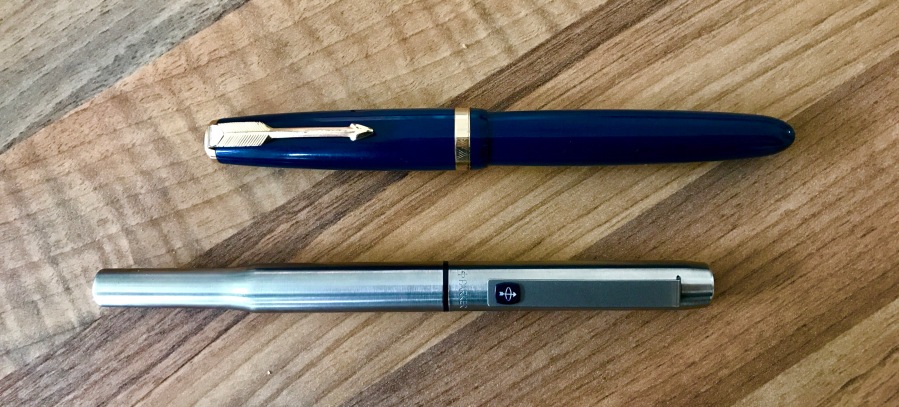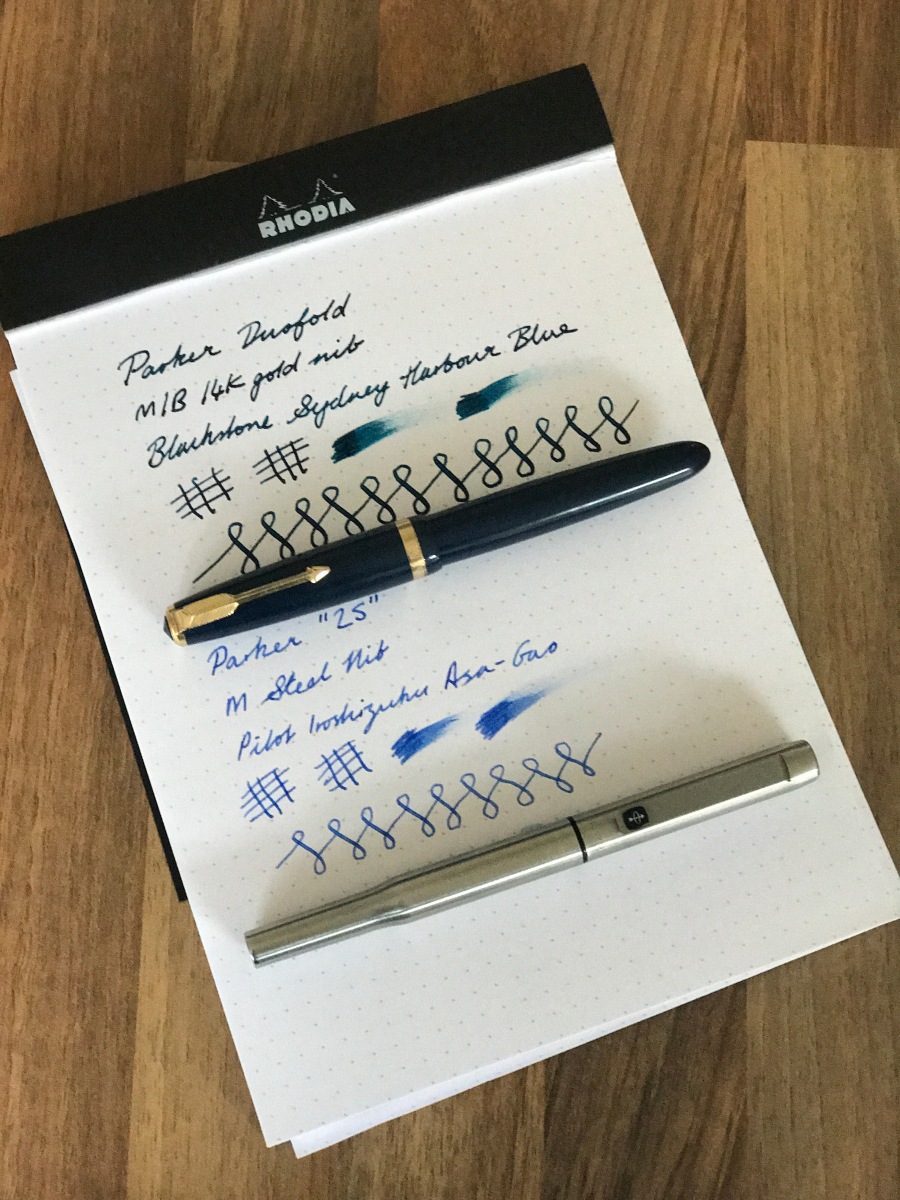I love old people. They are hilarious, impart much needed wisdom and often give you more sweets than you could ever eat in a lifetime.
The same cannot be said for old fountain pens. They seem scary, can be difficult to understand, and often spit (ink) at you when you touch them, like a stationery camel.
BUT…
…old fountain pens CAN look pretty hot and write like flexy goddesses. One of my favourite pens is a restored Conway Stewart Dinkie due to its acrylic good looks and INSANE flex nib.
So, one rainy afternoon a few weeks ago I decided to overcome this fountain pen fear through drastic exposure therapy. I set off for my local antiques quarter (yes, we have that many vintage shops in Sheffield they have their own city quadrant!), braced my wallet and went in search of vintagey goodness.
Here are my tips on what to do when buying a vintage pen – hard won experience from all my mistakes. You’re welcome.

1. Do your research first
I didn’t do this. I walked into an antique shop with the word ‘MUG’ tattooed across my forehead. I had no idea what I was looking at, just some vague common sense and lady luck on my side.
I did alright (as you will see…), but don’t be a dick like me. Work out what you are looking for. Do you want a particular brand like a Sheaffer or a Waterman? Is it a specific filling system that you want? Does swirly acrylic turn you on? Or – like most of us – are you after the flex nib to END ALL FLEX NIBS?!?
Once you’ve decided what you are after, look for tips and tricks on finding the best example of that pen. What warning signs do you need to look for that say ‘put the pen down and RUN!’ or ‘BUY IT NOW, BITCH’? I suggest reading this useful article on the Art of Manliness about how to research your first vintage pen purchase. Y’know, like I should have done before I handed over any cash ;).
2. Set your budget and your vendor
Also think about how much you want to spend, and be stricter with your wallet than a prison guard with a murderer. It can easily get out of hand: my £30 budget (modest I know), was nearly blown out of the water by a £78 Pilot VP from the 80s. But I didn’t know enough about it to take an expensive plunge into the unknown.
Consider where you are going to buy your vintage beauty from too. Pen dealers and pen shows are the most recommended options as you will be buying from pen nerds like us, who care and know about their wares. They might also have lovingly restored these pens back to decent condition. Be aware that you will have to pay the price for this though.
If you are like me and like to live dangerously, trawling around antiques shops can unearth some hidden gems for cheap money. I found lots of Conway Stewarts, a few Bexleys and even a few very VERY old Watermans. Again, I hadn’t the foggiest what to go for (due to the ZERO research I did), so I stuck with Parkers as…well they made me feel comfortable. Like a cuddle from your grandad.
I ended up buying a £12 Parker Duofold from the early 50s (which I had no idea was a Duofold until I Googled it after I bought it), and an 80s Parker Flighter 25 for £8. My main criteria for buying them were: does it look pretty? Do I like the colour? Does the nib look usable? Is the shop owner bending me over the counter with the price? I know, incredibly scientific.

3. Check for cosmetic wear, nib alignment and whether the filling system works
Before buying my old boys, I did have the sense to inspect them closely first. I’d looked at quite a few pens by this point, but most were filthier than Hugh Heffner’s search engine history. A lot of them had sprung nibs, misaligned tines or leaky sacs. (For those that don’t know, many old fountain pens are filled by pushing a lever on the side of the pen body/metal bar as part of filling mechanism to create a vacuum in an internal rubber sac. These are perishable and need to be intact for the pen to fill with ink.)

So, check your potential purchase for signs of irreversible wear, nib tine issues and fondle its sac. Keep an eye out for deep scratches, cracks and splits in the body and the nib too. Be realistic though, 60 year old pens are NOT going to look as fresh as a daisy. Just know the amount of work you are prepared to put in to clean them up.
For more in-depth info, this post on Richard’s Pens shows great insight into the danger signs to look out for on older pens.
4. Haggle
Always negotiate on price, and make them an offer they can’t refuse. In a nice way though, not like the Godfather.
This might be more difficult at a pen show or with a dealer, as they know their shit and have probably put a lot of effort into restoring your potential writing mate. However, I’ve found that antique shop owners are a little less savvy on fountain pen pricing. This makes me sound like a machiavellian cow, but I turned on the feminine charm and got my Duofold down from £20 to £12, and the Flighter from £15 to £8. I’ll see you on the next season of The Apprentice.
5. Put in the TLC when you get home
Whatever the state of your new-old pen, it will need a hunk’o love when it gets home. This can be as basic as a good soak, flush, polish and nib tweaking, to a full sac replacement and nib realignment. The Vintage Pens website gives a detailed description of how to love your vintage pen back to life.
As it was my first foray into vintage, I was prepared to do a little bit of cosmetic work. I left both pens to soak overnight, gave them a good flushing and polished the bodies with a jeweller’s cloth. This got rid of years old ink, and took out most of the scratches. Then came the moment of truth…will they write after all this tender care?!
6. Bask in glory when your pen writes like a dream!
Oh. My. God. THEY BLOODY WROTE!
And well too. The Duofold has a wonderfully wet medium-broad line with decent amount of flex. It is one of the smoothest nibs I’ve ever used and the gold trim and deep blue body have polished up a treat. An ideal companion for letter writing and headers.
The Flighter has fast become one of my daily carry pens. The nib isn’t anything special, but it is a reliable and smooth medium in a durable (and mean-looking!) outer body that stands up well in pockets. Fabulous work horse pen!

I have had a bit of a fluke when it comes to my first vintage fountain pen buying experience. Getting two pens for a rock bottom price that write well and look smart, is not the case for everyone that goes blindly stumbling into a bric-a-brac shop. BUT, go onnnnn, try it! There is something so magical about loving a pen back to life with your fair hands. And if it doesn’t work, you’ve only spent a tenner or so on the journey.
In the words of Dr Pepper, what’s the worst that could happen?!
Have you had any amazing vintage fountain pen finds?!








Hilarious – as usual 🙂 Your Dinkie is gorgeous. I managed to get 2 in 1 day. 1 wrote, the other didn’t – but I know a guy, so… This is how it starts 🙂
LikeLiked by 1 person
Haha omg I feel like this is a slippery slope…glad you enjoyed! What colour is your Dinkie?! They are so so small but so so amazing!
LikeLiked by 1 person
I got purple shiny Lumina (it’s a dinke) and then classic green (this bad boy needs a new sack :D). Being a ‘green’ person I am now on a hunt for shiny green Lumina, lol. Slippery slope it is…
LikeLiked by 1 person
You make me want a green one too…😂! I’d also like a bigger version…what will become of us!
LikeLiked by 1 person
I did the same and found a De La Rue green marble – one tine bent but otherwise ok and still wrote and then a Parker Classic 51 MKII for £9 in a charity shop and it still had its chalk marks. It writes like a dream. I liked the De La Rue and wanted to see it returned to its glory, so, now paid just under £50 to get it fully repaired. Sounds a bit mad but I think it’s worth it. I’m now a lot more canny about pens when looking for them.
LikeLiked by 1 person
Oh how i wish i was staying in the UK. currently staying in mordern singapore where vintage shops are considered derelict.
LikeLiked by 1 person